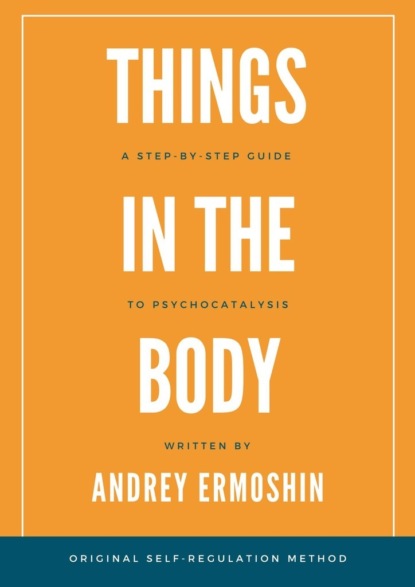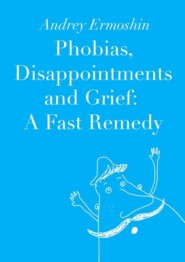По всем вопросам обращайтесь на: info@litportal.ru
(©) 2003-2024.
✖
Things in The Body
Настройки чтения
Размер шрифта
Высота строк
Поля
Questions are a natural part of the life process
We are going to talk about the questions that people can ask their body, but I have no doubt that the body itself is able to ask questions. In particular, with the help of dreams. Wakefulness is the “answer’ to dreaming. The dream poses a problem and real life serves its solution. You can say the opposite: a dream is a response to wakefulness. The life itself is questions and answers.
Psychotherapy and somatopsychotherapy, as part of our life, does not invent anything unnatural, it does not deal with something artificial. It only cleanses and gives patronage to everything natural.
The terms «facilitation’ and «amplification’ are well known. I use the term «psychocatalysis’. The fact, that psychocatalysis applies to the inner body sensations, became an important opening of the Russian school of BEST by E. I. Zuev and the basis of the development of this «question’ therapy.
«Ask me questions,» a patient often says, dropping themselves into a therapist’s chair (as if surrendering»). Who will do it, how will it be done, and what for?
The Key question
We can say that each system of psychotherapy has its own key question. (This does not automatically mean that it works by questions – and yet…)
The question of clinical psychotherapy: dynamics of what constitutional genetic type manifests itself in the experiences and events of this person’s life?
The question of psychoanalysis: when, under what circumstances, what affection of Id and prohibition by Super-Ego encountered in Ego and provoked the complex?
The question of Jungian therapy: what kind of distortion in the conscious life of the patient makes their subconscious mind «to take measures to equalize the situation» and «what exactly should a person do to regulate their relationship with the unconscious?[14 - Jung, C. G. Synchronicity. Collector. – Moscow: Refl-Buk, K.: Vakler, 1997, p. 13.]»
The question of Gestalt therapy: what is the need of the body which makes the «figure’ now, what is the «background’, what prevents the Gestalt from «closing’, what unfinished actions prevent a person from living «here and now’?
The question of NLP: in what modalities and submodalities there is the information that affects a person, how they «manage’ to be upset or, on the contrary, spirited. And so on.
The SPT question
At the diagnostic phase of SPT, a charge that deranges the patient’s consciousness focusing the energy of the body on itself (the substance “heat-heaviness’) is found.
The question that helps to find to this «charge’ is usually very simple: where is the sensation associated with a particular episode of life, with a particular fragment of a dream, with a particular picture, which the patient drew on the instructions of the doctor? At the level of head, chest, abdomen, or anywhere else? Is it something big, small, light, or dark? What is it «made of’? And so on.
Below we will take a closer look at the options of talking to patients, depending on how they declare their problem.
In fact, SPT offers the patients to think about a simple thing: how are their sensations distributed when they solve this problem? Or simply: how are their sensations distributed? Is there anything that disturbs the optimal distribution of sensations in the body? Is anything missing to feel good?
Where does the heat in the arms and legs reach? Are there any uncomfortable sensations concentrated at the level of an area of the body?
I will allow myself a short historical excursus.
Do not wait for any hair to appear on a tortoise shell
Before somatopsychotherapy I had a few years of practice in clinical psychotherapy.
What are its obvious advantages? Firstly, it is the interest in the constitutional and genetic basis on which certain mental processes are developed. A clinical psychotherapist at the first stage of communication with a patient finds out the specific features of the mentality of the latter, and at the last stage they help a patient to see the world as a meeting of different forms of life, each of which has their own purpose. The ultimate achievement of successful clinical work is the patient’s inner peace and tranquility based on self-acceptance as a certain natural entity, endowed with their own character, accepting others as well! «Do not wait for any hair on the shell of a tortoise,» says Taoist wisdom, quite «clinical’ in its essence). This is a substantial part of the work of a clinical psychotherapist, but I would like to draw your attention to something else.
“Storytelling’
A clinical psychotherapist pays much attention to the baseline state in which the communication between a doctor and a patient takes place. Even the most correct messages can be received by the patients only when they have a free resource for this. The fact is that their resources are mostly spent on tension and neurotic experiences.
Johann Schultz is known to have researched and described the basic sensations that a person experiences in the process of relaxation. They were named «six exercises of autogenous training’. A pleasant heaviness and warmth fill up the body then turning into a pleasant lightness and freshness. The heart beats calmly and evenly. Breathing is free and even. The solar plexus emits warmth. The forehead is slightly cool.
The state of the patients when «pleasant warmth reaches their fingers and toes, and the roots of their hair’ is healing in itself. In clinical psychotherapy it is also the background for the patients to accept themselves, the situation and to adjust to a successful way out of difficulties.
It should be noted that sometimes this part of the work is not the second, but the first one: instead of talking to the patient in their «abnormal’ state, the therapist invites them to the session, which is called «learning auto-training’, «hypnosis’ or something else. Only after nonspecific calming in a cozy environment, under the influence of relaxing music, words of «comfort’ with the lulling intonation, and storytelling, the patient is «taken’ to more specific work.
The psychotherapeutic “swing’
At the early stage of my professional development my working combination was conversationplus relaxation. After discussing with the patients their important issues, I offered them to close their eyes and let the feelings to be distributed. Partly, that was the pre-system of the work I am describing now.
Conversation-relaxation-conversation – this rhythm began to seem more natural and important. It is a kind of a psychotherapeutic «swing’. The second part (hypnotic and auto-training) changed its tone in the process of «working out’ this practice. If, at first, I tried to imbue something to the patients at that phase (based on the material of the previous study of their problems), then later I refused to be directive and often offered just to observe the sensations after the conversation, to let them «lie down’.
The questioning observation: question without question
Offering patients to observe what happens after a usual empathic hearing often leads to surprising results. Patients connect to their body sensations, fall into a kind of trance, and undergo a series of transformations, often spontaneously describing the process that, in fact, is organized by psychocatalysis in somatopsychotherapy.
The stones of unease can be detected and disintegrated, sensations can move actively from one area of the body (overfilled) to another (devastated), completely new and optimized contours of sensations can be formed. The convalescents get into the new spaces, from which they come back renewed. It is like auto-trainingwithout instructions. Conciliation, calming down, and rebalancing occur spontaneously, in accordance with the «program’, which the body choses itself.
He sat down and began to describe
Recently, I was impressed by a kind of echo of my old “mute’ practice (mute, because it has a minimum number of questions with maximum confidence in own healing process of the body). This story is about the transformations that a twelve-year-old boy began to experience, as soon as he sat down on a chair and heard the words: “Close your eyes. Describe what you feel.”
The boy had a weakened immunity of unclear genesis. He had been suffering from furuncles for a long time. The last two months he was continuously treated for submandibular lymphadenitis (there was a crack in the corner of his mouth, through which he, apparently, got the infection). Two operations under general anesthesia were unsuccessful. He underwent a lot of bandaging, and there was constantly a tubule for drainage in his wound. Of course, he had to forget about going to school.
The boy was brought to me just after he had been bandaged once again. He sat down on a chair and fell into a special state of connection with attention to inner sensations – a kind of trance. He began to describe his sensations in detail without any instructions from me, except for the most general one: «Watch and describe.» The boy understood the main instruction perfectly, though it didn’t say: «Heal.»
The movement of sensations was very intense. The terrible heat was gathering in his chest and there was the feeling of a huge furuncle.
«Will you let him break through?»
«No.»
The boy felt as if he «put his hands in the oven’, then two dinosaurs were fighting in front of his eyes. Then, after a bright flash, everything disappeared.
First, his head «weighed 300 pounds’, then his legs did. Then «a worm slid on his hip and jumped out,» and «a turtle with a small shell, a long neck, big eyes and a silly smile made him laugh’. At last, being weightless, he began to «flip’ in the air.
«Count how many times.»
«Five.»
He began to «flip’ in the air again. This time he had ten «flips.»
A series of transformations, which lasted for about thirty minutes, ended with the formation of a sensation of even heat throughout his body, and the boy felt the opportunity to open his eyes.
A lump of cottage cheese
I was interested in following the outcome of his healing after that process of spontaneous self-regulation. I asked about the condition of the boy in a month. He was healed. Two months later I met him once more.
He maintained balance in his sensations. He enjoyed playing with his friend. «Everything is good. I can play and jump,» he said. Only a small crimson scar under his jaw reminded about his former problems.
«Scars adorn a man,» I remarked.







